Outdoor wood boiler vs. outdoor wood furnace
How does a forced air wood furnace work
Comparison of an outdoor wood boiler vs outdoor wood furnace
- forced air (hot air) wood furnace
The main difference between the forced-air
furnace and a water furnace, is that air circulates around the firebox, instead
of water, so no pump is needed. A fan is used to circulate the air (which is
included, just like a pump is included on our boilers).
The forced-air furnace can only heat one building because there is only one
thermostat hookup and cannot heat your domestic hot water like the boiler can.
Any other building cannot be thermostatically controlled if both are to be the
same temperature (or with a damper).
A water furnace (outside boiler) can heat virtually unlimited buildings and more
than one hot water heater.
A forced-air furnace has to be relatively close your home because of the expense
of the pipe and the air flow losses, if it's too far away.
You could consider this an outdoor forced air wood furnace
review
Review of a wood or coal hot air furnace and how it compares to a wood or
coal boiler.
How does a forced air wood furnace work you ask?
A forced air wood furnace heats up the firebox
and the air surrounding it, much like a traditional furnace will heat up a heat exchanger.
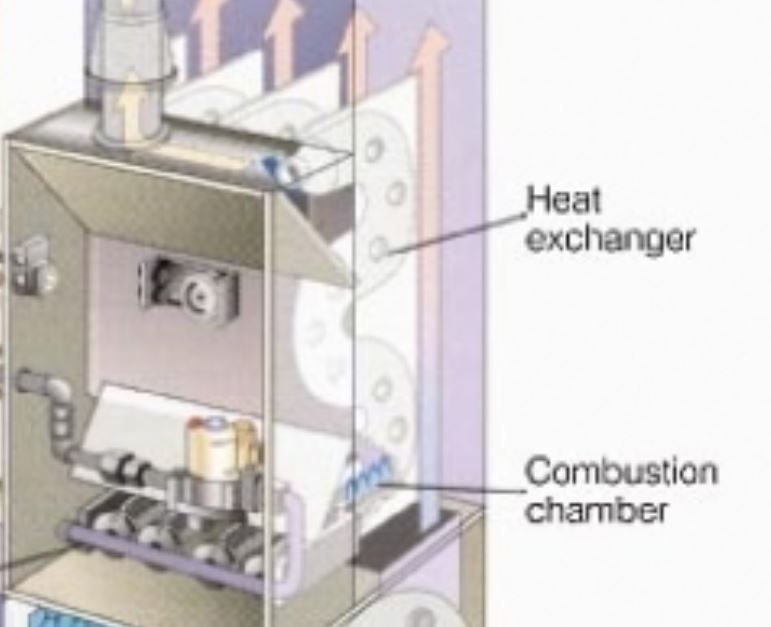
Heat exchanger in gas furnace
In a forced air furnace the firebox IS the heat exchanger,
only needing a big (2000 CFM) blower to blow hot air into your home.
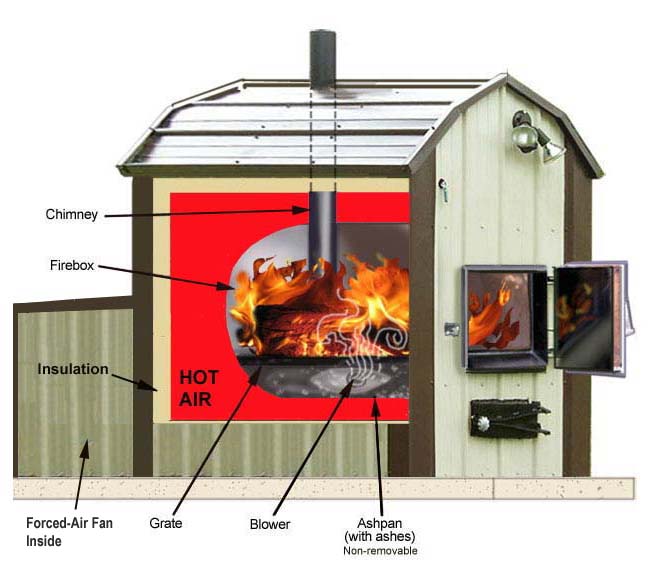
This image depicts the previous round firebox design. They are still built with
one piece of steel, the firebox formed formed with a 430-ton press brake.
The advantage of this configuration is less welds than a traditional firebox
which is a literal box; taking 12 welds to assemble six flat slabs of steel into
a box. Both the design above and the new firebox only has to have 2 welds
to weld the end plates on! The new design requires 2 more welds (but not
12!) to weld the firebox to the water jacket bottom. This enables you to
have a water jacket bottom the same thickness as the firebox. No one else
in the world does this!
One of the biggest differences it is in the operation. A water furnace will only
come on to heat up the water and it only does that every few hours and then will
shut off when the water reaches temperature. The fire would not ignite again
until the water temperature drops sufficiently to require it to be reheated.
By contrast, the forced air furnace operates just like an indoor furnace; it
will likely come on for 20 min. and then shut off for 20 min. and then come back
on for 20 min. and repeat. This causes somewhat more smoke than a water furnace
because that is the only time you have smoke (5 to 10 minutes); is when it is
building a fire.
Most people don't care because you have your doors and windows closed in the
winter and are rarely outside but I wanted to point that out, in case you have
kids playing outside in the winter time frequently.
You can use less expensive galvanized ducts but then it may not look as good
aesthetically (not hidden underground).
A forced-air furnace requires 2 ducts - supply and return; either standard
inexpensive duct, or two buried insulated 12" ducts. With the standard
inexpensive duct, it normally runs through a wall or window - and is visible,
unless a chase is built to house the ductwork, like the Army Corps of Enginers
did for their warehouse with one of our Hyprotherm hot air furnaces.
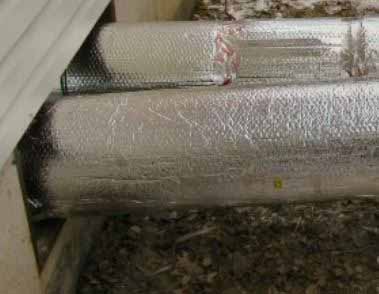
Ductwork from a Hot Air forced-air furnace through a basement window to the
existing ductwork.
The underground duct is $20 a foot and you need two ducts plus you will usually
need four elbows, which are $125 each. Clamps can be a total several hundred
dollars ($50 each), depending on how many you need. Min of 10 per pack.
You would use standard inexpensive round 12" metal duct to get from the
back of the furnace to the pipe in the ground. Read more and see pictures at http://www.outdoorwoodfurnaceboiler.com/FORCED-AIR-OUTSIDE-WOOD-BURNING-FURNACE.htm
The pipe is shipped from their factory. You can see info and videos at http://www.aqcind.com/the-blueduct/
Here is a photo of the insulated underground blue ductwork connected to our hot
air furnace and a mobile or modular home:
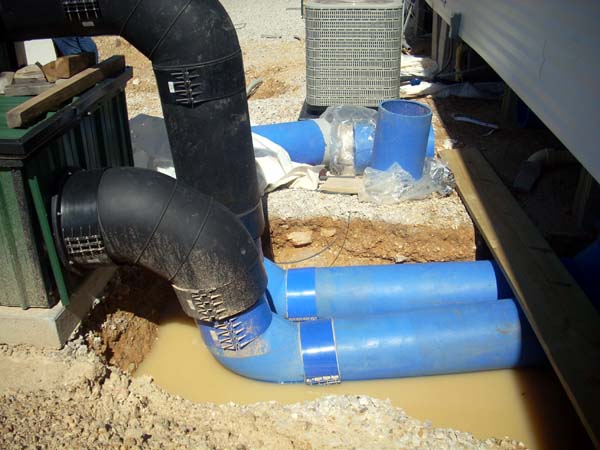
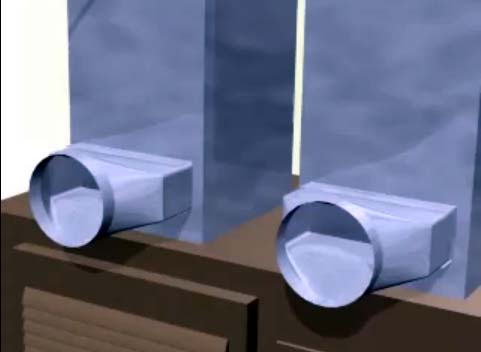
Flanges/adapters to connect the 12" round ductwork to you excising square
or rectangular duct/
Standard metal 12" duct is usually $3-5 a foot.
The only other items needed are 110V wire and a thermostat wire.
The furnace needs to be a min. of 5 feet from your home (according to U.L tests)
but ideally within 40 feet from your existing ductwork,
for less heat loss and air flow losses.
Blue Duct should be buried below the frost line because it is always 50-55 F, no
matter where you live, so that is like having the duct outside on a spring day
instead of in frigid winter temperatures; saving you a lot of energy and wood.
_________________________________________________
In case you haven't noticed, everyone says they are the best, so you have to
look at the facts and decide for yourself. Look at our weight, simplicity and
features combined with an unprecedented 20-year ON-SITE warranty make is the
best, I am sure you will agree.
Note that many furnaces don't have an ash
pan, forcing you to clean the ashes out of the firebox - while the fire is
burning (or you have to let it cool down).
There are no fancy (expensive) electronics or circuit boards to burn out at the
first power surge or electrical storm.
Our fan, on both the hot air furnace and the boiler (the blower
inducer, that feeds oxygen to the fire) is in the back and blows air up through
the grate, feeding oxygen into the fire from the bottom, just like a
blacksmith's forge - the best way! Many furnaces don't have a fan at all
and others have a fan on the front door, blowing air into the side of the fire,
not in from the bottom where it's needed.
Our chimney drops down in the firebox, trapping in the heat and gases, to
maximize heat transfer and ensuring you're not heating the outside air! This
huge secondary burn chamber that is created, allows you to burn off all the
gases that first ignite, when you throw in a new piece of wood. This is valuable
heat, normally lost.
This design is one of the reasons that we achieved the high efficiency rating!
Most other manufacturers have their chimney right at the top of the firebox,
allowing so much precious heat to escape!
One other thing is that these water-less hot air furnaces are 100% legal in 49
States because they are not boilers which most state laws and the Federal law
are against, for heating a residence.
Ben at WNC Stoves
828-683-0025 9 AM - 9 PM ET, 6 days a week
Remember, the 20 year parts AND labor ON-SITE warranty is probably the best
feature because at least 50% of the manufacturers out there require that you
ship the furnace back to the factory to get it repaired. Then they have to ship
it back and while the repair may be free, they charge you for the shipping both
ways AND you have to disconnect the furnace, reinstall it and be without it for
2-4 weeks.
Please find the installation manual at that link here:
http://www.outdoorwoodfurnaceboiler.com/INSTALLATION-INSTRUCTIONS-AIR-TO-AIR.doc
Please call with any and all questions!
Remember there is no sales tax when it is shipped to your home!
MENU
HOME/Index
All
about WNC Stoves
20-year
ON-SITE WARRANTY
Wood
Boiler for 2000 sq. foot house
Hyprotherm
Wood Boiler HOME | BENEFITS
of an Outdoor Wood Boiler | Outside
Wood Boiler FAQ
Outdoor Wood Boiler PICTURES | PURCHASE
and PRICES | Financing
| Layaway
Proper
Insulation in an outdoor wood boiler
SHIPPING a Wood Boiler | Outdoor
Coal Boilers | Wood
vs Electricity and Propane Costs |
BTU
of different Wood Species
INSTALLATION
| Installing
a Heat Exchanger
RADIANT Heat from a Wood Boiler
Stainless
Steel vs. Mild Steel in Outdoor Wood Furnaces
Smallest
Mini BOILER | Boiler
for 2000 sq. ft home |
Pool
Heater
Best
Outside Wood Boiler |
Wood-Fired
Air Conditioner COOLING! | Driveway
and Walkway Snow Melt
Top
Loader Boilers
BLOG - Outdoor
Wood Boiler Advantages
CONTACT
WNC Stoves - 6 DAYS a WEEK at 828-683-8055
SITE
MAP

